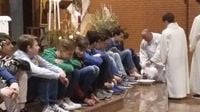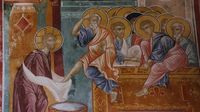On April 17, 2025, Christians around the world observe Holy Thursday, marking the beginning of the Paschal Triduum, a pivotal moment in the liturgical calendar. This day commemorates the Last Supper of Jesus with his disciples, during which he instituted the sacraments of the Eucharist and the priesthood. The significance of this day is encapsulated in the celebration of the "Messa Cena del Signore," or the Mass of the Lord's Supper, which renews the Eucharistic sacrifice.
During the Last Supper, as described in the Gospels, Jesus shared bread and wine with his disciples, establishing the Eucharist as a lasting memorial of his sacrifice. This act is not merely a ritual; it is a profound invitation for believers to remember and participate in the mystery of faith. As the Catholic Church reflects on this event, it emphasizes the multifaceted nature of the Church, where various ministries and charisms converge in Christ.
In the spirit of this celebration, the washing of feet is a significant ritual that takes place during the Mass. This act symbolizes humility and service, echoing Jesus' gesture of washing the feet of his apostles. The Gospel of John recounts how Jesus, at the Last Supper, rose from the table, wrapped a towel around his waist, and washed the feet of his disciples—a powerful expression of love and servitude. This moment serves as a poignant reminder of the call to serve one another with humility.
The washing of feet, as practiced in many churches, often involves the priest washing the feet of twelve faithful, representing the apostles. This ritual not only commemorates Jesus' actions but also invites the congregation to embrace a lifestyle of service and love. The act of washing feet transcends mere tradition; it becomes a living testament to the Christian commitment to humility and mutual care.
As the evening progresses, many congregations participate in the "Visita ai Sepolcri," or the visit to the Sepulchres. This tradition involves visiting altars where the Eucharist is reserved, symbolizing vigilance and anticipation of Christ's Passion. The faithful gather in prayer, reflecting on the profound sacrifice that Jesus made for humanity. This moment of quiet contemplation allows believers to connect deeply with the significance of the events that will unfold in the coming days.
The Paschal Triduum, which spans from the sunset of Holy Thursday to the evening of Easter Sunday, encapsulates the essence of the Christian faith. It is a time of reflection, prayer, and preparation for the celebration of Christ's resurrection. Each day of the Triduum holds its unique significance: Good Friday commemorates the Passion and death of Jesus, while Holy Saturday is a day of silence and waiting, culminating in the joyous celebration of Easter Sunday.
In the context of Holy Thursday, the Church also reflects on the teachings of the Second Vatican Council, particularly Lumen Gentium 10, which emphasizes the common priesthood of the faithful. This document highlights the interconnectedness of the ministerial priesthood and the priesthood of all believers, illustrating how both participate in the one priesthood of Christ. This theological foundation reinforces the importance of community and shared responsibility within the Church.
Cardinal Carlo M. Martini, in his homily during the Holy Thursday of the Holy Year 2000, articulated the essence of this celebration: "During the Last Supper, Jesus takes the bread, gives thanks to God, breaks it, and says: ‘This is my body.’ After supper, he takes the cup and says: ‘This is my blood of the covenant.’ In his hands, the bread and wine become himself. When he places a piece of that bread in the hands of Peter, John, Andrew, and Judas, it is as if he says: ‘It is I, do not be afraid, I place myself in your hands, I trust you.’"
This profound trust exemplifies the relationship between Christ and his followers, inviting them to become one with him through the Eucharist. The celebration of Holy Thursday is thus not only a remembrance of past events but a call to live out the teachings of Jesus in the present.
Moreover, the washing of feet serves as an invitation to overcome barriers and pride, embodying the essence of Christian love. As Benedict XVI interpreted, this gesture represents Jesus' serving love that liberates us from arrogance and opens our hearts to God. It is a powerful reminder that true greatness lies in serving others, a message that resonates deeply in today's world, often marked by division and self-interest.
In various regions, different traditions flourish around Holy Thursday. In Calabria, for instance, priests wash the feet of twelve individuals seated around a large table with twelve blessed loaves of bread, which are later distributed among the faithful. In Sicily, particularly in Enna, churches remain open for the faithful to visit the Sepulchres, engaging in a communal journey of prayer and meditation. Such customs enrich the liturgical experience, fostering a sense of community and shared faith.
As the faithful participate in the rituals of Holy Thursday, they are called to reflect on their own lives and relationships. The actions of Jesus—washing feet, sharing bread, and offering wine—serve as a model for how they should interact with one another. The challenge remains to embody these values of humility, service, and love in daily life, echoing the sentiments of the Last Supper.
Ultimately, Holy Thursday invites Christians to enter into the mystery of faith more deeply, recognizing that the Eucharist is not merely a ritual but a transformative encounter with Christ. As they gather to celebrate the "Messa Cena del Signore," they are reminded of their call to live out the Gospel in a world that desperately needs the light of Christ's love.
In this sacred time, as the Church reflects on the institution of the Eucharist and the priestly ministry, may all believers embrace the call to serve one another, following the example set by Jesus during that fateful night.







